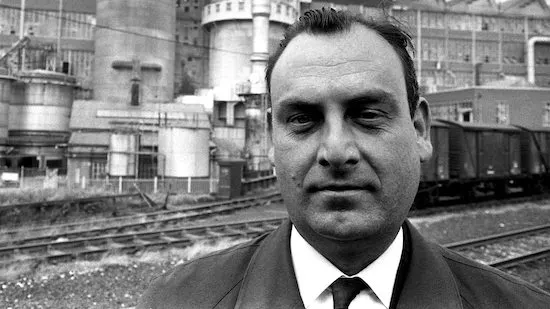Low Culture Essay: Travis Elborough On Ian Nairn's No Two The Same
In this month's Low Culture Essay, Travis Elborough revisits No Two The Same, a documentary about London's Pimlico that reveals many of the foibles of its creator, thirsty outsider and outspoken architecture critic Ian Nairn

Each time I watch No Two The Same some new oddity jumps out at me. On this occasion it’s Nairn’s skinny necktie. If Bo Diddley had a rattlesnake, then Nairn here has something that looks more like an eel, one valiantly trying to escape his stiff white collar and embark on its migration to the Sargasso Sea. No tie should look quite this errant and unruly, but there it is, cutting curious criss-cross shapes and tying itself in knots. The tie is all the more striking for the contrast it makes with Nairn’s bulky frame, and already rather puffy face. And then there is the discomfort with which, standing in the middle of the Lillington Estate, he’s posed: speaking directly to camera with a left arm he clearly doesn’t know what to do with. It’s tucked awkwardly behind his back, that side of the suit jacket dragged back with it, like a twitched curtain.
No Two The Same is a 1970 essay film by the architectural writer Ian Nairn about the area of Pimlico in London, produced by the Government funded Central Office of Information, a post-war successor to the wartime propaganda unit the Ministry of Information. Nairn’s biographers Gillian Darley and David McKie observed that ‘just to watch’ this film is filled with a kind of ‘deep’ embarrassment for all concerned and not least Nairn himself. And they are not wrong. His language is, as they say, ‘stilted and awkward’ throughout and his attempts to interact with even a specially selected set of local residents makes for often excruciating viewing. And yet I am drawn back to it again and again as a fascinating social document and equally for what it seems, inadvertently or otherwise, to tell us about Nairn, especially in this of all years, the 40th anniversary of his death. It's something I've been even more acutely aware of while writing the introduction to a new edition of Nairn's Modern Buildings in London, a primer on the best of contemporary architecture in the capital that was first published by London Transport in 1964.
To continue reading this Low Culture Essay, you'll need to become a tQ Low Culture or Sound & Vision subscriber
Find out more here (S'ouvre dans une nouvelle fenêtre)
Déjà membre ? Connexion (S'ouvre dans une nouvelle fenêtre)


